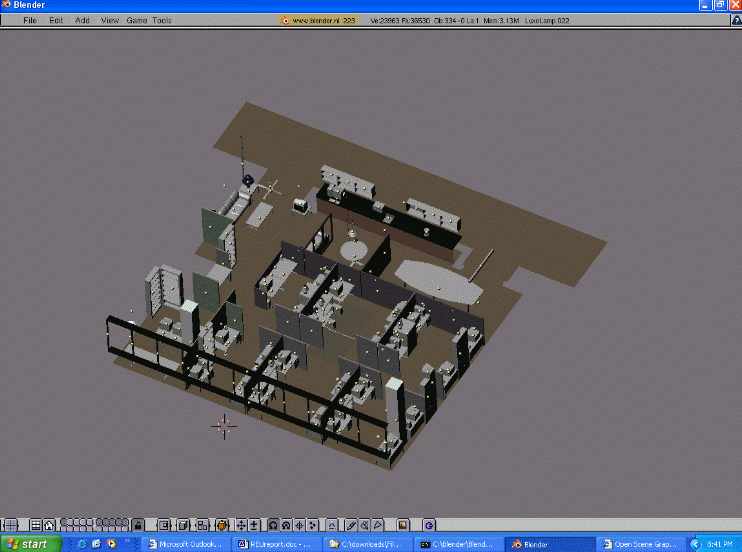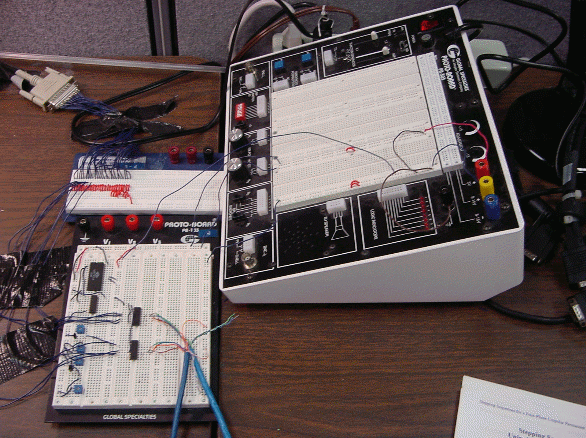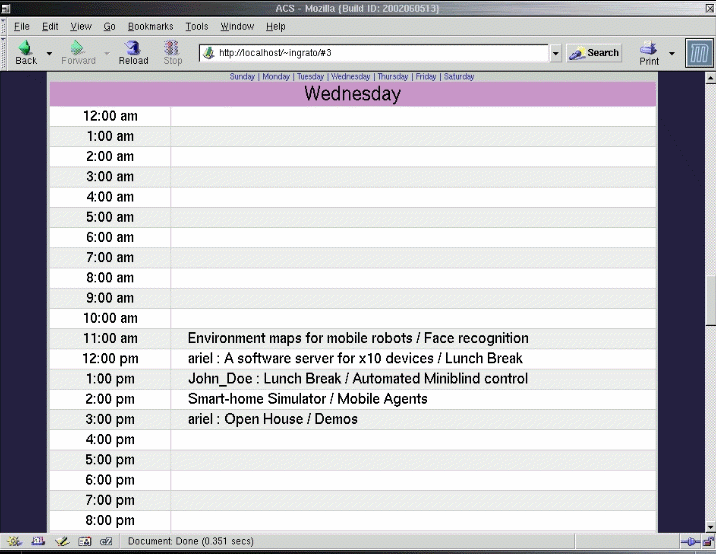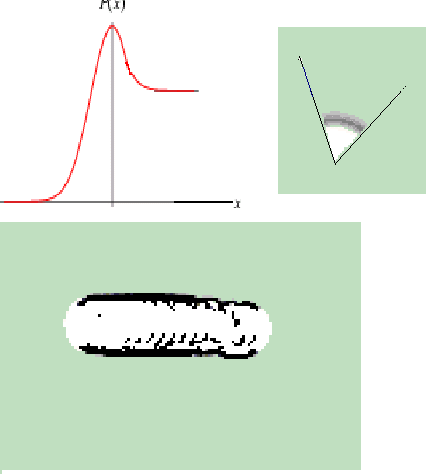
Research Experiences for Undergraduates in Distributed Rational Agents
Open House 2002

Nine undergraduate participants of the REU summer program and three undergraduate students supported through NSF REU supplements participated in the REU Open House 2002 to present their research projects.
ResiSim -
Residential Home Simulator:
![]()
 Three
REU students were involved in the development of a simulator for
intelligent homes. The goal here is an interactive real-time
simulation environment that realistically represents physical
aspects of a home and allows for the testing of algorithms used in
the control of the house. Furthermore, the simulator should allow
for remote viewing of events at the users desired time rate. As
events occur in the simulator or in the actual world, the same
should happen in each counterpart. During the summer program, the
REU participants investigated different simulation engines,
rendering techniques, and interfaces to the hardware components. As
a result they constructed a simulation using OGRE (Object-Oriented
Graphics Rendering Engine) and Blender3d. Major challenges addressed
in this project were the development of novel techniques to simulate
the large number of lights, the integration of the individual
modeling and rendering components and the construction of interface
modules to the sensor infrastructure and in particular to the X10
device server. The figure shows a view of the simulator.
Three
REU students were involved in the development of a simulator for
intelligent homes. The goal here is an interactive real-time
simulation environment that realistically represents physical
aspects of a home and allows for the testing of algorithms used in
the control of the house. Furthermore, the simulator should allow
for remote viewing of events at the users desired time rate. As
events occur in the simulator or in the actual world, the same
should happen in each counterpart. During the summer program, the
REU participants investigated different simulation engines,
rendering techniques, and interfaces to the hardware components. As
a result they constructed a simulation using OGRE (Object-Oriented
Graphics Rendering Engine) and Blender3d. Major challenges addressed
in this project were the development of novel techniques to simulate
the large number of lights, the integration of the individual
modeling and rendering components and the construction of interface
modules to the sensor infrastructure and in particular to the X10
device server. The figure shows a view of the simulator.
A
Corba-Based Server for X10 Devices:
![]()
The purpose of this project was to create a set of applications that will allow intelligent monitoring and control of a house's lights, motion sensors, appliances, etc. To make this applicable to average homes, X-10 devices using the X-10 power line protocol were chosen as the hardware components. One REU participant investigated the interface and processing issues involved in making these devices easily accessible to a general set of intelligent control components and to the residential simulator described above. As a result of the project, a hierarchical, distributed architecture consisting of room servers and a house server was developed and implemented. To permit easy and flexible access, all server components were wrapped in CORBA interfaces. The distributed implementation was chosen to reduce the amount of down time if one of the room servers crashes and to reduce the likelihood of a complete house wide failure of monitoring or control.
Hardware and
Software for Automated Miniblinds:
![]()
 Besides
X10 devices, an additional device to be controlled was the
mini-blinds. This project was performed by an REU participant
together with a student supported on an REU supplement grant. The
goal here was the development and implementation of hardware and
software to permit for the intelligent control of the blinds from a
computer. In the course of the summer program, prototype hardware as
well as a CORBA-based interface were developed. The figure shows
the prototype hardware.
Besides
X10 devices, an additional device to be controlled was the
mini-blinds. This project was performed by an REU participant
together with a student supported on an REU supplement grant. The
goal here was the development and implementation of hardware and
software to permit for the intelligent control of the blinds from a
computer. In the course of the summer program, prototype hardware as
well as a CORBA-based interface were developed. The figure shows
the prototype hardware.
 Two
REU participants were involved in investigating mobile agents for
distributed applications. The goal was to provide a virtual computer
agent that would mobilize to other computers to perform a set task
in the context of a calendar system that would allow a set of
trusted users to set and synchronized events within the user group.
To achieve this, the students studied a number of available
technologies and developed a system consisting of mobile agents and
a centralized server that provides agents with the ability to locate
other agents in the network. In this framework, the mobile agents
query the server for the appropriate computer locations and move to
the respective computer to perform synchronization and event
retrieval tasks at that site. All processing is performed by the
mobile agents on the local computer rather than at a central
location. The figure on the left shows a view of the user interface
to the calendar application.
Two
REU participants were involved in investigating mobile agents for
distributed applications. The goal was to provide a virtual computer
agent that would mobilize to other computers to perform a set task
in the context of a calendar system that would allow a set of
trusted users to set and synchronized events within the user group.
To achieve this, the students studied a number of available
technologies and developed a system consisting of mobile agents and
a centralized server that provides agents with the ability to locate
other agents in the network. In this framework, the mobile agents
query the server for the appropriate computer locations and move to
the respective computer to perform synchronization and event
retrieval tasks at that site. All processing is performed by the
mobile agents on the local computer rather than at a central
location. The figure on the left shows a view of the user interface
to the calendar application.
Environment
Mapping for Mobile Robots:
![]()
 Robotic
agents are an important component of an intelligent home. To
address the tasks required and to interact with humans, however,
they have to be able to perceive their environment. To achieve this,
an REU participant developed and implemented a probabilistic mapping
system for a mobile robot based on prior work by a number of
researchers including A. Elfes, S. Thrun, and D. Fox. As part of the
project a sensor model for sonar sensors was developed and a mapping
system was developed. The figure on the left shows the sensor model
used and the results obtained while moving the robot along a
hallway.
Robotic
agents are an important component of an intelligent home. To
address the tasks required and to interact with humans, however,
they have to be able to perceive their environment. To achieve this,
an REU participant developed and implemented a probabilistic mapping
system for a mobile robot based on prior work by a number of
researchers including A. Elfes, S. Thrun, and D. Fox. As part of the
project a sensor model for sonar sensors was developed and a mapping
system was developed. The figure on the left shows the sensor model
used and the results obtained while moving the robot along a
hallway.
 The
goal of this project was to design a face recognition system that
would work as a security system. With a camera placed above a door,
the system would only admit authorized people into the home.
Starting with a face recognition package from the University of
Colorado at Boulder, an REU participant developed the system by
adding components that permit the finding of the face in the image
and by altering the face recognition code in order to make it
interactive rather than batch-style. The resulting system permits to
dynamically extend the face database and to perform individual
queries on-line using a camera image. The figure on the left shows
an example sequence in the face recognition process. From left to
right this figure shows the initial image, the face localization and
extraction, and the recognized face from the database.
The
goal of this project was to design a face recognition system that
would work as a security system. With a camera placed above a door,
the system would only admit authorized people into the home.
Starting with a face recognition package from the University of
Colorado at Boulder, an REU participant developed the system by
adding components that permit the finding of the face in the image
and by altering the face recognition code in order to make it
interactive rather than batch-style. The resulting system permits to
dynamically extend the face database and to perform individual
queries on-line using a camera image. The figure on the left shows
an example sequence in the face recognition process. From left to
right this figure shows the initial image, the face localization and
extraction, and the recognized face from the database.
For additional information regarding this program please contact:
Manfred Huber
University of Texas at
Arlington
Department of Computer Science and Engineering
Box
19015
Arlington, TX 76019-0015
Email: reu@cse.uta.edu
* This project is funded by NSF grant EIA-0139564